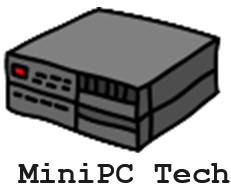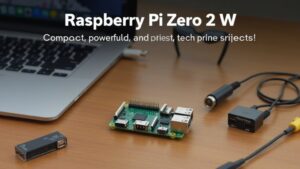The Raspberry Pi Zero 2 W delivers impressive performance upgrades in a tiny package, ideal for various applications. You’ll notice its quad-core CPU greatly boosts processing speed, reaching about 80% of the Raspberry Pi 3B’s power. Connectivity options have expanded with faster wireless capabilities and Bluetooth 5.2 support. Its low power consumption makes it perfect for IoT projects, while gaming performance shows substantial improvement over previous models. Although limited by 512MB of RAM, its compact design suits embedded systems. This device’s versatility caters to makers, educators, and hobbyists alike, and there’s much more to explore about its features and benefits.
Key Takeaways
- The Raspberry Pi Zero 2 W offers up to 5x faster performance than the original Pi Zero, with improved processing capabilities approaching the Raspberry Pi 3B.
- Its compact size (65mm x 30mm x 5mm) and light weight (16 grams) make it ideal for portable and embedded applications.
- Connectivity options include enhanced 2.4GHz Wi-Fi, Bluetooth 5.2, and Ethernet over USB, facilitating versatile IoT applications.
- The device supports gaming and emulation with frame rates reaching nearly 60 FPS in classic arcade games, providing a significant upgrade over its predecessor.
- It is suitable for various projects including IoT systems, educational purposes, and DIY security setups, making it a versatile computing solution.
Overview of Raspberry Pi Zero 2 W
The Raspberry Pi Zero 2 W represents a significant leap in performance and versatility for compact computing. With its quad-core CPU, this device is up to five times faster than the original Pi Zero, enabling rapid execution of user applications. You’ll notice dramatic improvements in file compression tasks and enhanced performance in multithreaded programs, which showcases its capability in demanding scenarios. Additionally, it features Bluetooth 5.2 capabilities, allowing for improved connectivity options and making it an even more ideal choice for IoT projects.
The board’s design also benefits from low power consumption, making it suitable for embedded applications and wearable tech. Software compatibility remains a strong suit for the Zero 2 W, as it’s designed to work harmoniously with most HATs and pHATs. This guarantees that existing code and applications can run smoothly, catering to various projects, from robotics to advanced machine learning. Additionally, the board includes a single mini HDMI port, allowing for straightforward connection to displays and enhancing its usability for visual projects.
The performance increase not only supports more sophisticated applications but also paves the way for innovative endeavors in areas like image recognition and IoT solutions.
While it provides a decent desktop experience, remember that its 512MB RAM limits multitasking efficiency. It’s essential to manage expectations for standard desktop use.
Hardware Specifications
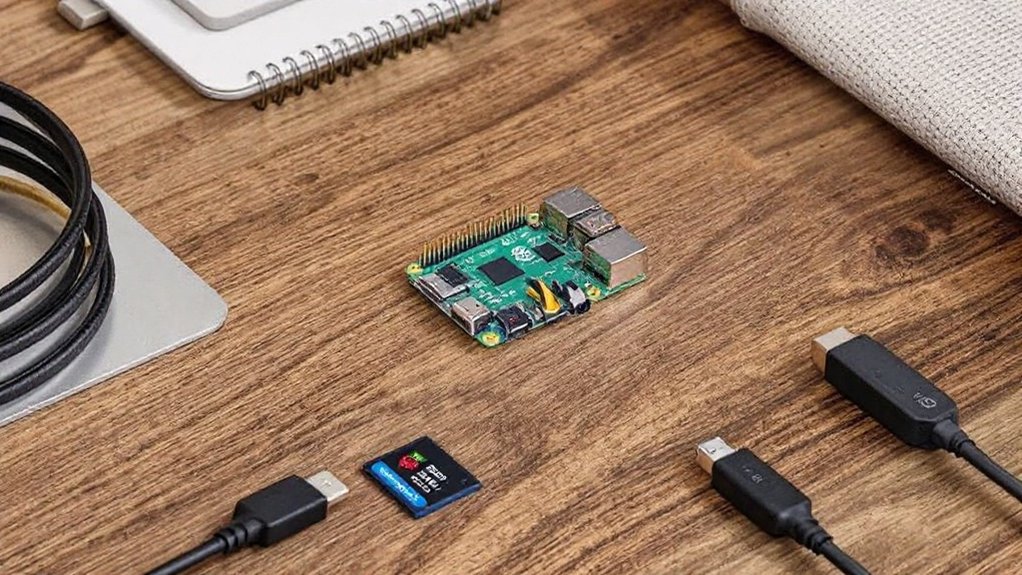
The Raspberry Pi Zero 2 W elevates hardware specifications through an enhanced processor that dramatically outperforms its predecessor in both single- and multi-threaded tasks. You’ll appreciate the robust connectivity features, including Wi-Fi and Bluetooth, which expand its versatility for various projects. However, despite the performance improvement, the device retains 512 MB RAM, limiting its capabilities for more demanding applications. Additionally, it’s noteworthy that the available RAM accounts for graphics memory and OS overhead, influencing overall performance. Plus, its compact design guarantees it fits seamlessly into tight spaces, making it ideal for portable applications. For optimal performance, ensure you use a Class 10 microSD card to handle the operating system efficiently.
Enhanced Processor Performance
When evaluating the Raspberry Pi Zero 2 W, you’ll notice a remarkable upgrade in processor performance thanks to its Broadcom BCM2710A1 processor. This quad-core 64-bit Arm Cortex-A53 CPU, clocked at 1 GHz, delivers a substantial 40% increase in single-threaded performance and an impressive five-fold improvement in multi-threaded tasks compared to its predecessor. Such enhancements provide excellent performance optimization for demanding applications.
The integrated system-in-package (SiP) design, which combines the CPU and 512MB LPDDR2 SDRAM, enhances processor efficiency while maintaining a compact form factor. Raspberry Pi RP3A0 System-In-Package design contributes to this overall efficiency by streamlining the hardware layout and improving thermal performance. Additionally, the connectivity features of the Zero 2 W enhance user experiences by providing solid networking capabilities, though it lacks support for 5GHz Wi-Fi networks.
With improved memory bandwidth driven by its quad-core architecture, you’ll experience faster data processing and smoother multitasking capabilities. Tasks like file compression, which once took considerable time, are now completed in less than half the duration of the original Zero.
Additionally, the upgraded graphics capabilities, including OpenGL ES 1.1 and 2.0 support, prepare you for more demanding visual applications.
Connectivity Features Overview
With an impressive range of connectivity options, the Raspberry Pi Zero 2 W is designed to meet the demands of modern projects. You’ll benefit from its onboard 2.4GHz 802.11 b/g/n wireless LAN, ensuring robust wireless compatibility. Plus, with Bluetooth 4.2 and support for Bluetooth Low Energy, connecting peripherals becomes hassle-free. However, it’s essential to recognize that there’s no 5 GHz wireless capability, which can limit network performance in crowded environments. The single USB On-The-Go (OTG) port introduces USB limitations by requiring an OTG cable for standard USB devices. To expand your functionality, you’re advised to use a powered USB hub for connecting multiple devices. The Pi Zero 2 W excels when paired with wireless input devices, such as a keyboard and mouse, optimizing space and reducing cables.
For video output, you’re equipped with a mini HDMI port, supporting high-definition formats, though composite video output is also available. Additionally, Ethernet over USB capabilities allow for flexible network access using gadget mode. The board is powered by a 1GHz quad-core CPU, enabling enhanced performance for multitasking and complex projects. Furthermore, the use of VNC installation can greatly enhance your remote desktop experience when working with the Raspberry Pi.
Compact Design Specifications
Compact yet powerful, the Raspberry Pi Zero 2 W showcases impressive hardware specifications that cater to a variety of applications. Weighing just 16 grams and measuring only 65mm x 30mm x 5mm, its compact design guarantees easy portability benefits without compromising performance.
The quad-core 64-bit CPU, based on the Arm Cortex-A53 architecture, runs at 1GHz, delivering a remarkable 40% increase in single-threaded performance and up to five times the multi-threaded performance compared to its predecessor. Additionally, this new model retains its HAT-compatible 40-pin header, which allows for seamless expansion with various accessories and add-ons. Notably, the device is equipped with Bluetooth Low Energy, enhancing its connectivity features for a wide range of projects.
With 512 MB of LPDDR2 SDRAM, the Raspberry Pi Zero 2 W leverages efficient memory management despite the absence of onboard storage, relying instead on a microSD card slot for flexible data storage options. The standard 40-pin GPIO header and compatibility with previous Zero models allow effortless integration into existing projects and systems.
Additionally, the device includes essential connectivity options like a mini HDMI port and two micro USB ports, enhancing its versatility in various setups.
This blend of compact design and robust specifications makes the Raspberry Pi Zero 2 W a compelling choice for makers, developers, and anyone seeking innovative solutions in a diminutive package.
Performance Enhancements
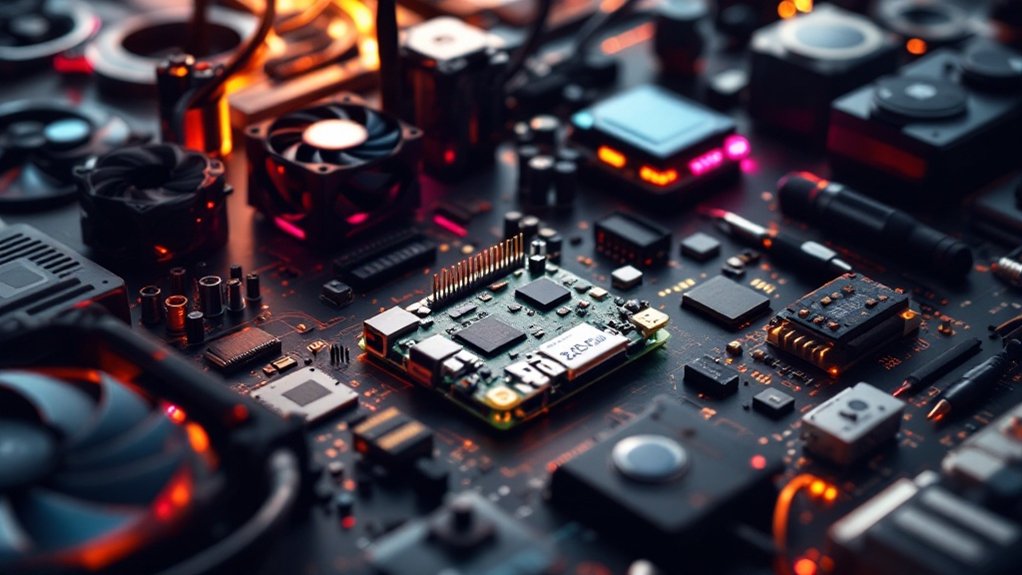
Maximizing performance, the Raspberry Pi Zero 2 W displays significant enhancements over its predecessor, primarily due to its upgraded CPU architecture. Utilizing the Broadcom BCM2710A1 SoC, this model features a quad-core Cortex-A53 processor clocked at 1.0 GHz, which is overclockable to 1.2 GHz.
These performance upgrades yield about 80% of the processing power of the Raspberry Pi 3B, with single-core performance surging 40% compared to the original Pi Zero W.
In practical terms, you’ll experience noticeably quicker boot times—up to three times faster with Raspberry Pi OS. The overall system responsiveness is markedly improved, offering a snappier user experience that makes daily tasks feel less sluggish. Additionally, the board’s thermal stability during benchmarks demonstrates effective heat management even under high loads. The device’s maximum power consumption is only 1.5 W, further contributing to its efficiency.
However, the 512 MB RAM limits capabilities for more demanding applications, affecting web browsing and YouTube playback noticeably. You’ll find this board excels in multi-threaded benchmarks, maintaining thermal stability under load without throttling.
Efficiency is also remarkable. Even under rigorous CPU tests, it remains fairly power-efficient, consuming only marginally more than its predecessor, making it a great choice for mixed CPU-and-memory workflows.
Ultimately, the performance enhancements make the Raspberry Pi Zero 2 W a compelling option for a variety of innovative projects.
Connectivity Options
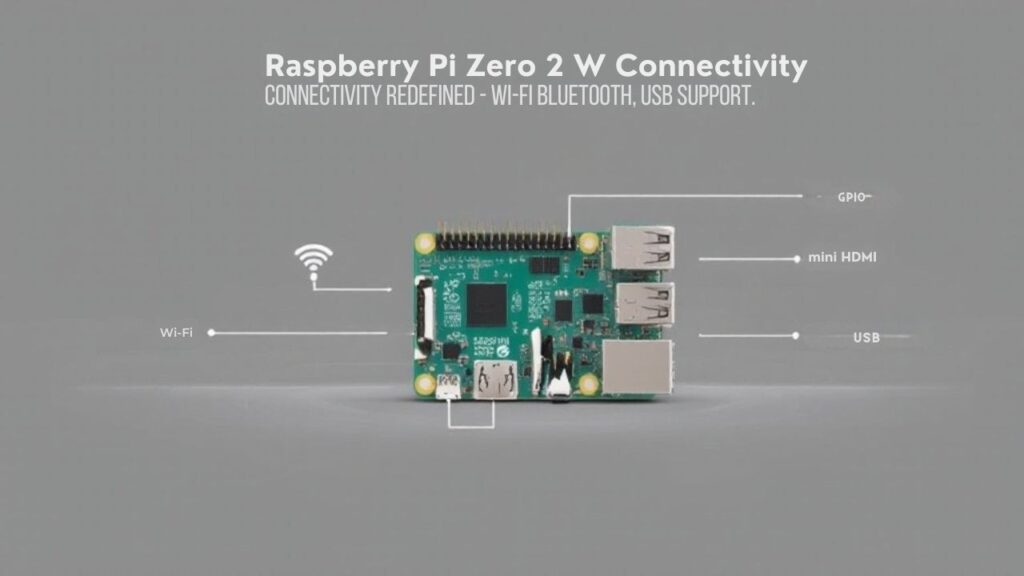
Connectivity options on the Raspberry Pi Zero 2 W are versatile, offering a range of features to suit various needs.
You’ll benefit from wireless connectivity with the built-in 2.4GHz IEEE 802.11b/g/n wireless LAN, which provides performance approximately twice as fast as its predecessor, the Pi Zero W. While this enhancement brings speed, you should note that it lacks support for 5GHz WiFi, making it susceptible to congestion in crowded environments.
Bluetooth 4.2, including Bluetooth Low Energy (BLE), further enhances your wireless options, allowing seamless connections to various Bluetooth devices like keyboards and mice. However, the Bluetooth version remains unchanged from the Pi Zero W. Additionally, the Raspberry Pi Zero 2 W supports WiFi and Bluetooth connectivity, reducing the need for additional USB ports.
Despite these robust wireless capabilities, keep in mind the USB limitations. The single USB 2.0 interface with On-The-Go (OTG) capability means you’ll need a special USB OTG cable for connecting standard USB devices, and the absence of a second USB port can hinder multitasking. Additionally, the device’s performance has improved with the new RP3A0-AU chip, making it more efficient for multitasking than its predecessor.
Additionally, with only a microUSB socket for power, you’ll need to manage your peripherals wisely. The Pi Zero 2 W compensates for these drawbacks with a mini HDMI port, HAT-compatible GPIO header, and a microSD card slot for storage.
Power Consumption and Heat
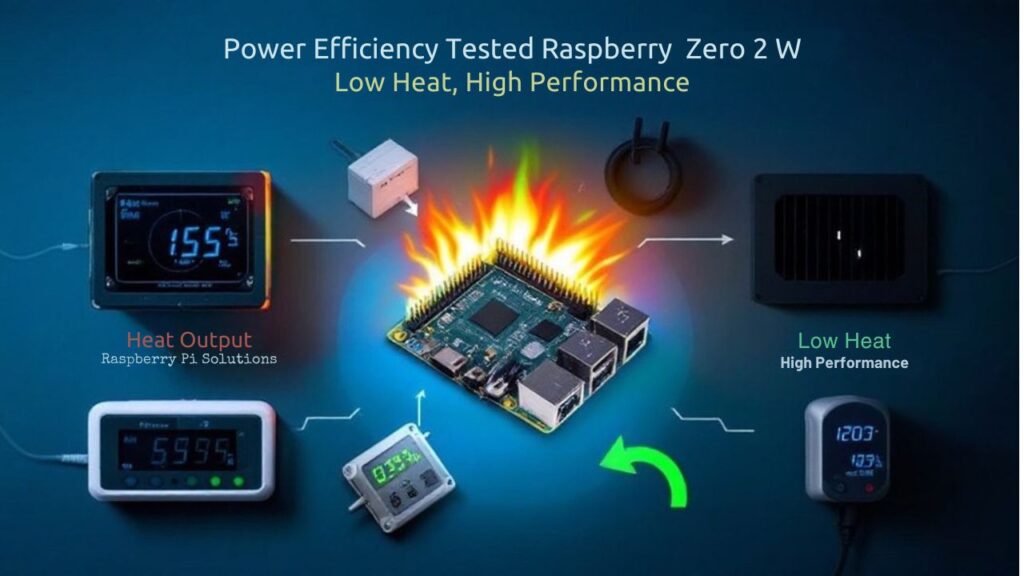
Power consumption and heat generation are critical considerations when working with the Raspberry Pi Zero 2 W, especially for users pushing the device to its limits.
The Pi Zero 2 W boasts improved power efficiency but consumes about 2.3092W during active use, which is roughly 1.4 watts more than its predecessor, the Raspberry Pi Zero W. While idling, it still uses more energy, indicating that careful power management is essential, particularly in battery-operated projects. Additionally, the Zero 2 W’s performance increase significantly contributes to its higher power consumption. Notably, the FLIRC Zero case provides superior thermal performance, helping to further manage heat during intensive workloads.
As for heat, benchmarking reveals that the Pi Zero 2 W runs about 1.5 times warmer than the Zero W, with throttle kicking in at 80°C to prevent potential damage.
Utilizing thermal management strategies, such as employing a case with a built-in heatsink, can markedly mitigate temperature spikes. If you push the Pi Zero 2 W under continuous heavy loads or overclock it, consider active cooling solutions to maintain stable performance and avoid overheating.
Usability in Desktop Mode
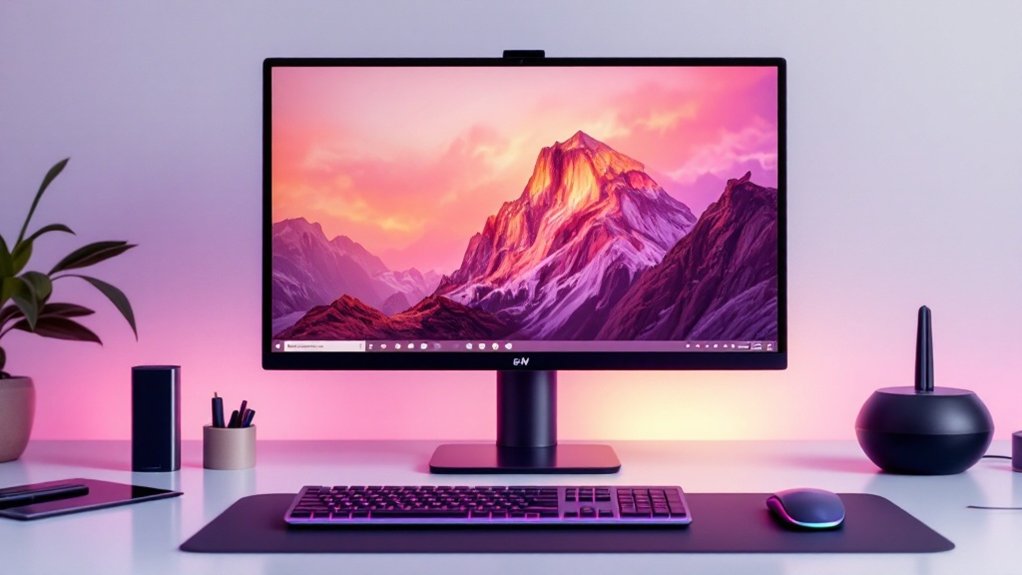
Maneuvering the usability of the Raspberry Pi Zero 2 W in desktop mode reveals both promise and constraints. While the quad-core 1GHz processor provides a decent foundation, the mere 512MB of SDRAM creates significant desktop limitations. The improved performance of the quad-core architecture enhances capabilities for multitasking, but you might still find performance sluggish, especially during screen redraws and menu navigation. Although employing a 32-bit OS can mitigate some of this memory pressure, the experience isn’t ideal for daily tasks unless your needs are exceptionally modest. Additionally, the mini HDMI port allows you to connect to various displays, yet the limited RAM still hampers overall effectiveness. If you’re considering remote management, using SSH proves more efficient than local desktop interactions. You can seamlessly connect via VNC for a smoother experience, which is particularly advantageous for coding and debugging through tools like VS Code. The device’s cost of $15 for the device makes it an accessible option for those with low computing needs.
Gaming and Emulation Capabilities
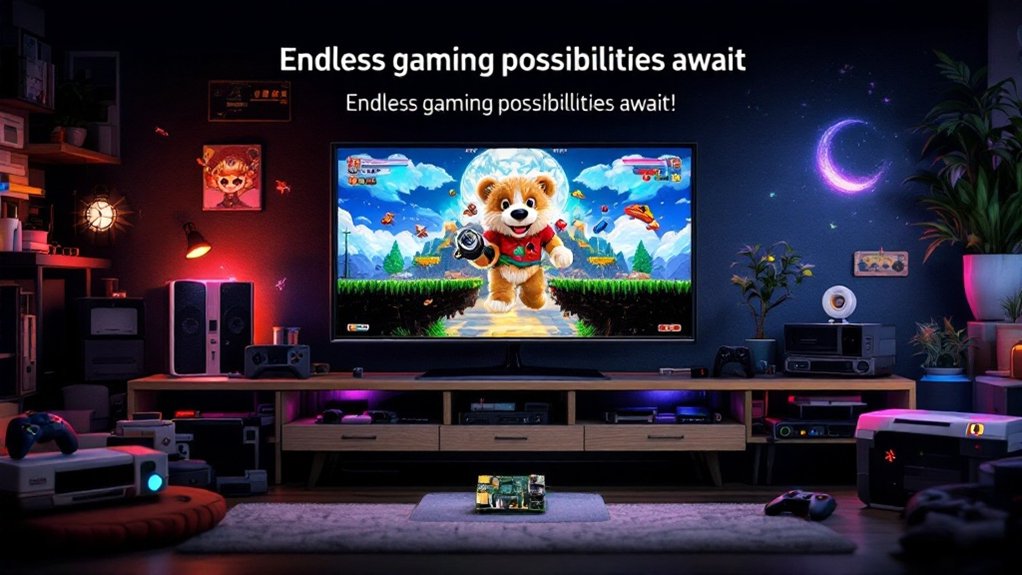
When it comes to gaming and emulation, the Raspberry Pi Zero 2 W delivers a notable upgrade over its predecessor. With a significant performance boost, you’re looking at nearly 60 frames per second in arcade classics like Metal Slug, compared to the previous 50 FPS. This enhancement extends to Sega Mega Drive/Genesis titles, allowing you to enjoy games like Vector Man and Gunstar Heroes at full speed. The device supports a wide range of retro gaming consoles, including SNES, Gameboy, PlayStation, and even Dreamcast, bringing nostalgia to life with improved performance. Additionally, Recalbox is recommended for compatibility with the Raspberry Pi Zero 2, simplifying the installation process even further.
While Nintendo 64 emulation is almost feasible, it may require some tweaking to hit that sweet spot of stable play. Compatibility with popular emulation software such as RetroPie and Recalbox makes installation straightforward, ensuring you spend less time setting up and more time gaming. The Raspberry Pi Zero 2 W’s quad-core architecture enhances its ability to run multiple emulators simultaneously without significant drops in performance.
Other emulators like rycast and redream further expand your options, particularly for Dreamcast titles. With all these features, the Raspberry Pi Zero 2 W stands out as a compelling choice for anyone looking to plunge into retro gaming and experience classic titles with greater fidelity and performance.
Benchmark Results
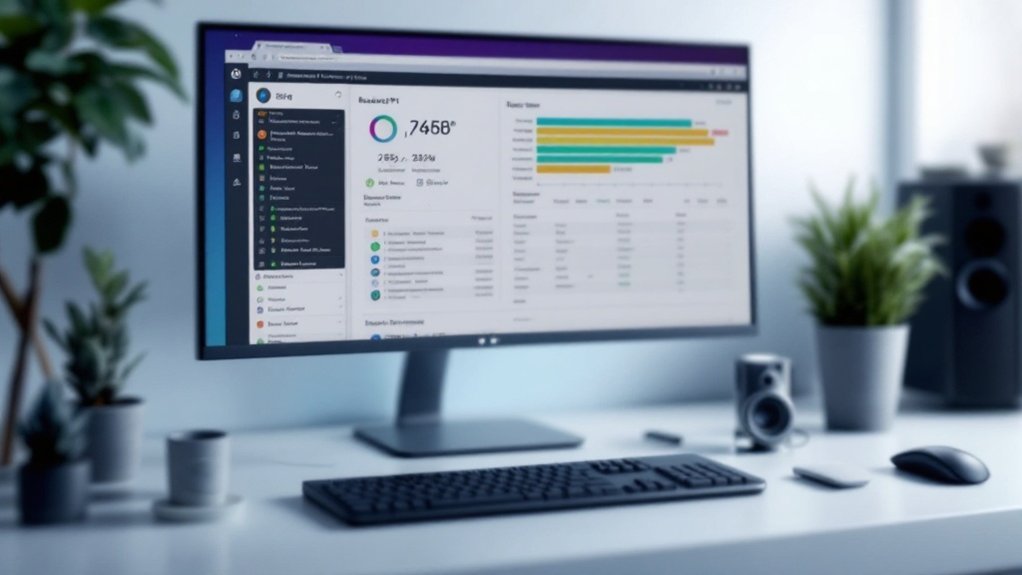
In evaluating the Raspberry Pi Zero 2 W’s performance, you’ll notice marked improvements across several benchmark categories.
Multi-threaded tasks show significant gains, while browser benchmarks highlight its efficiency compared to earlier models.
Additionally, gaming frame rates demonstrate the potential for a better experience, making it a compelling choice for various applications.
Multi-threaded Performance Gains
The Raspberry Pi Zero 2 W showcases impressive multi-threaded performance gains, largely due to its quad-core Cortex-A53 processor. This upgrade facilitates your projects with remarkable multi-threaded advantages, positioning it as a competitive player for budget-friendly SBCs.
In fact, when all four cores are utilized, you’ll experience performance that’s roughly five times higher than its single-core predecessor, the original Raspberry Pi Zero.
You’ll find its benchmark results compelling; for example, during the John the Ripper multi-threaded tests, the performance is strikingly close to that of the Raspberry Pi 3. Similarly, C-Ray benchmarks confirm that the Zero 2 W almost matches the performance of the Raspberry Pi 3, affirming its effectiveness in demanding applications.
Despite its 512MB RAM, which can occasionally be a bottleneck, the overall snappiness and responsiveness greatly enhance your experience compared to the previous model.
Even when overclocked to 1.2 GHz, the Zero 2 W manages to perform comparably to the Raspberry Pi 3 B+ without any throttling, showcasing excellent performance optimization in various scenarios.
This board delivers a new level of efficiency for modest workloads and innovative projects alike.
Browser Benchmark Comparison
With its improved architecture, the Raspberry Pi Zero 2 W stands out in browser performance benchmarks compared to its predecessor. The enhancements in CPU utilization and memory management deliver noticeable gains in browser speed.
Here are some key highlights:
- Load Times: Initially, the Chromium browser on the Zero 2 W takes around 45 seconds to load pages, but optimizing the swap file size cuts that down to approximately 16 seconds.
- Speed Comparisons: In the Speedometer 2.0 benchmark, the Zero 2 W performs six times better than the original Zero, although it’s still around one-third of the Raspberry Pi 4’s performance.
- Rendering Efficiency: The device renders web pages considerably faster, making browsing more tolerable despite its 512MB RAM limitation, which can lead to occasional memory issues.
While the Zero 2 W showcases improved browsing capabilities, keep in mind that high CPU load remains a constant.
Switching to lightweight browsers like Links2 can alleviate some performance woes, but at the cost of functionality.
Gaming Frame Rate Evaluation
Elevating your gaming experience, the Raspberry Pi Zero 2 W brings a significant performance boost over its predecessor, making frame rate challenges a thing of the past. With its quad-core Cortex-A53 processor, you can now enjoy smoother gameplay and higher frame rates in an array of games. This enhanced performance is similar to the benefits seen in energy-efficient mini PCs used in home labs.
Here’s a concise look at how various games perform on the Pi Zero 2 W compared to the original:
| Game | Frame Rate (Pi Zero 2 W) | Frame Rate (Original Pi Zero) |
|---|---|---|
| OpenArena (720p) | 28 FPS | N/A |
| Metal Slug | 60 FPS | 50 FPS |
| Gunstar Heroes | Full emulation speed | Almost unplayable |
| Super Mario 64 (Tweaked) | Nearly playable | N/A |
| Sega Mega Drive Emulation | Nearly 60 FPS | Low 20s |
The results illustrate significant frame rate optimization, resulting in enhanced gaming experiences. Whether it’s old-school arcade classics or demanding retro games, the Pi Zero 2 W revitalizes your gaming escapades, ensuring that nostalgia meets performance like never before.
Comparisons With Previous Models
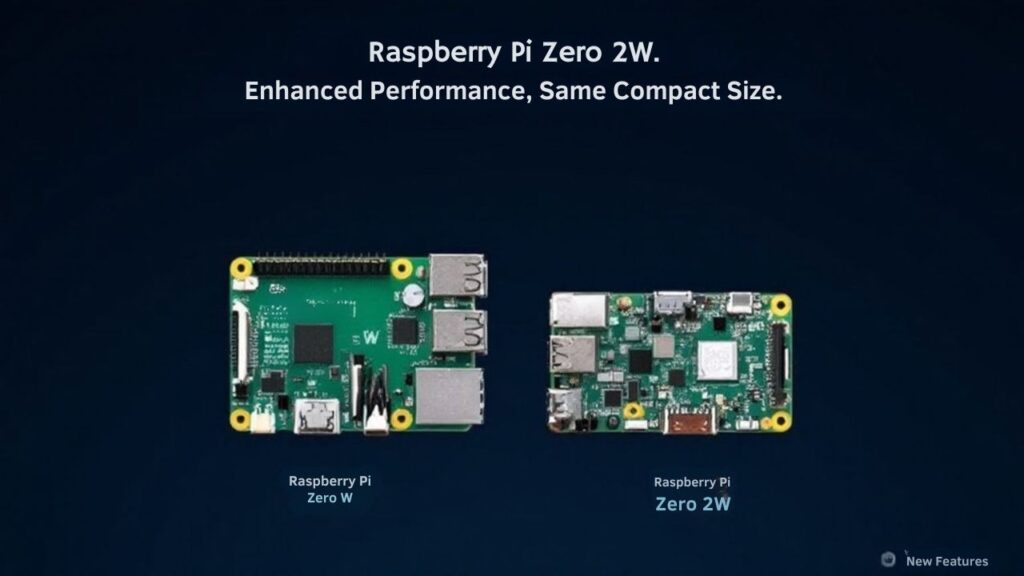
Upgrading from the Raspberry Pi Zero W to the Raspberry Pi Zero 2 W brings significant enhancements in performance and capabilities.
If you’re considering the trade-offs, it’s essential to recognize the key areas where the new model shines compared to its predecessor, particularly in light of the Zero W limitations.
- Processing Power: The Zero 2 W features a quad-core Arm Cortex-A53 at 1GHz, making it five times faster for multi-threaded workloads compared to the single-core Arm11 of the Zero W.
- Enhanced Performance: With a 40% improvement in single-threaded performance and advanced heat management, you can push the Zero 2 W much harder without worrying about overheating.
- Improved Connectivity: While both models share similar connectivity options, the Zero 2 W’s Bluetooth 4.2 LE offers a slight edge over the Zero W’s Bluetooth 4.1 LE.
These Raspberry Pi comparisons illustrate why the Zero 2 W may serve as a better value proposition for those looking to build innovative projects, especially when considering cooling solutions to prevent overheating.
The improvements not only enhance performance but also make the limitations of the Zero W more apparent, nudging it toward obsolescence in the face of this new model.
Ideal Use Cases
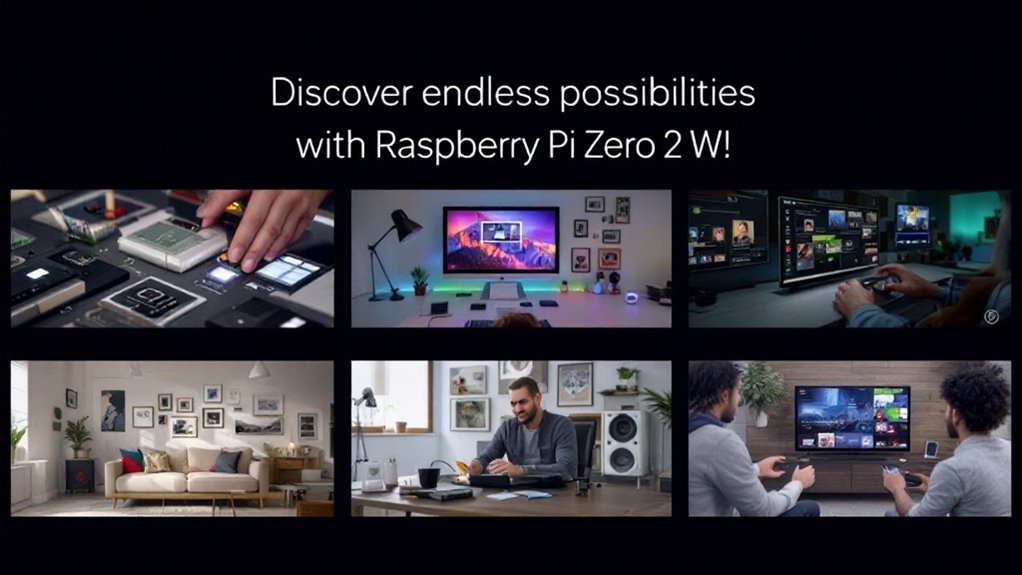
The Raspberry Pi Zero 2 W stands out in various applications, making it a versatile choice for developers and hobbyists alike.
One of the most compelling use cases is in IoT applications, such as smart lighting systems. You can automate your lighting based on occupancy or daylight levels, integrating sensors that adjust brightness dynamically to enhance energy efficiency. Plus, it’s compatible with WiFi and Bluetooth for remote control, offering voice recognition support for hands-free operation. This aligns well with the need for fanless designs that ensure silent operation and reduce hardware failure risks.
Another ideal scenario involves environmental monitoring. This compact device helps you track temperature, humidity, and air quality in real-time, ensuring a comfortable indoor environment. Alerts can prompt actions based on your predefined thresholds, making home automation seamless.
In the area of security, the Zero 2 W is perfect for DIY systems. Set up video surveillance or smart home security integrations that automate alerts and routines based on sensor inputs. Its low power consumption makes it feasible for continuous operation.
Frequently Asked Questions
What Operating Systems Can I Run on Raspberry Pi Zero 2 W?
You can run Raspberry Pi OS, Ubuntu, and specialized systems like LibreELEC on the Raspberry Pi Zero 2 W. OS compatibility guarantees diverse user experiences, while performance benchmarks highlight significant improvements compared to earlier models.
Does Raspberry Pi Zero 2 W Support HDMI Output?
Yes, the Raspberry Pi Zero 2 W supports HDMI output, offering versatile HDMI connectivity and display options. You can configure it for ideal video resolutions, enhancing your visual experiences with smooth performance and innovative capabilities.
Can I Use Raspberry Pi Zero 2 W for Machine Learning Projects?
Thinking about using it for machine learning? You can, but keep in mind its limited data processing and model training speeds. For serious projects, consider pairing it with a Coral TPU to boost performance considerably.
What Power Supply Should I Use for Raspberry Pi Zero 2 W?
You’ll need a power adapter that meets the voltage requirements of 5V and at least 2.5A for peak performance. Using the official supply guarantees compatibility, ensuring your projects run smoothly and efficiently.
How Does the Raspberry Pi Zero 2 W Compare in Price to Other Models?
The Raspberry Pi Zero 2 W, at $15, offers significant value compared to other models. Its pricing reflects upgraded features, positioning it competitively within the Raspberry Pi pricing landscape, ensuring good performance for its cost.
Conclusion
To sum up, the Raspberry Pi Zero 2 W proves itself as a compact powerhouse, marrying efficiency with performance. Whether you’re diving into DIY projects or exploring emulation, this little device packs a punch without breaking the bank. Its improved specifications breathe new life into a classic line, making it a must-have for tech enthusiasts. If you’re seeking versatility in a small package, the Zero 2 W stands ready, much like a Swiss army knife for your digital creativity.

I am a retired software engineer with experience in a multitude of areas including managing AWS and VMWare development environments. I bought a relative a mini-PC a year ago and have become passionate about the technology and its potential to change how we deploy software.
